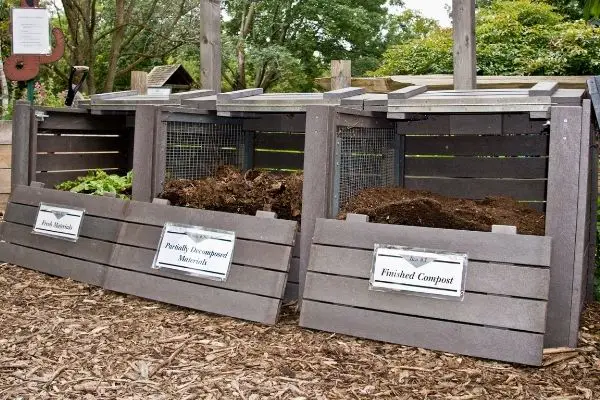How To Hide A Compost Bin (with Style)
I don’t want to sound like I am the compost police, but up around 30% of our household trash is made from food scraps and yard waste – according to the Environmental Protection Agency (EPA), I get really excited about this topic.
That large amount of food and garden trash when in landfills leads to the production of greenhouse gases, but when composted and returned to the garden, it makes a fantastic nutrient-rich soil.
So, there’s really no excuse NOT to compost! In fact, you don’t even need a garden – certain methods such as Bokashi composting are very apartment friendly.
With that said, many people have trouble justifying adding a compost pile to their backyard. It can be hard to find enough space to spare. And even harder to keep your active compost out of sight from your patio or passersby.

If you, like me, are worried about the aesthetics of building a compost heap on your property, rest assured that there are several ways to hide it from view!
And it is not just aesthetics, it is also about finding a place where the process can occur as efficiently as possible.
Where is the Best Spot for a Compost Bin?
Choosing the right location for your compost can promote efficient decomposition and keep your backyard looking its best.
Place your compost on level ground to prevent shifting — this isn’t a major concern if you’re using an enclosed bin or tumbler. Be sure your compost is within reach of a reliable water source.
If possible, keep your compost far away from garden beds (especially those containing fruit or vegetables). This will decrease the risk of rodents and insects hopping from your compost to your garden.
Another factor you might need to consider is your neighbors.
While a healthy compost pile shouldn’t smell terrible, you don’t want to risk annoying your next-door neighbors with unexpected odors. Plus, not all neighbors will appreciate a compost heap that is visible from their property.
How to Hide a Compost Bin
Ideally, you should place your compost in an out-of-the-way spot. No one wants to walk around a compost heap located in the middle of the lawn!
But what if your backyard lacks a convenient corner, you might need to come up with other ideas to hide your compost heap.
Plant Bushes
One of the best ways to disguise any style of compost pile is with large ornamental plants.

Dense flowering shrubbery, such as lilacs, roses, or hydrangeas, will hide your compost heap while adding color to your garden. They may even help cover up any unwanted odors during the blooming season.
A potential drawback to using shrubbery is that your compost will only be completely obscured for part of the year. Plant evergreen species to disguise the compost during the fall and winter, as well.
Install a Trellis
Another great strategy for hiding a compost bin is with a trellis. This method is very similar to planting shrubs but with much more flexibility.
During the growing season, you can plant the trellis with fast-growing vines like clematis or climbing roses. In the fall and winter, the mostly bare trellis will continue to provide some cover.
Build a Fence
There are two ways you can use a fence to hide a compost bin.
First, you can use fencing panels to construct a barrier around your compost heap. Many gardeners construct compost bins out of wire fencing. To completely hide the compost inside, however, you’ll want to use wood panels.
Second, you can build a fence encircling the general area of your compost. This takes up a bit more space but ensures you can still access the bin as needed.

Either way, be sure to build a fence that extends above the top of your compost pile. You may need to install a cut-out or removable panel to easily access the compost for adding materials or turning.
Frequently Asked Questions
Should you cover compost?
In most cases, covering a compost bin or pile is not necessary. It can even interfere with natural decomposition by blocking airflow and messing with the internal moisture and temperature.
Temporarily covering your compost bin can keep out excess rainwater and unwanted insects. It can also help protect your compost from unseasonably cold temperatures.
Some compost bins are specifically designed to work best with a cover. If you own one of these composters, refer to the manufacturer’s directions for the most accurate information.
Does compost smell bad?
Learning how to hide a compost bin will do little good if the odor gives it away. But healthy compost should have minimal smell to it.
If your compost bin is giving off a foul odor, there’s a good chance the conditions inside are less than ideal.
Common reasons for smelly compost include too much moisture, an overabundance of nitrogen-rich matter, and adding non-compostable kitchen scraps like meat or dairy. Once the root cause is addressed, your compost bin should stop stinking up the backyard!
Should compost be placed in the sun or shade?
Either location is fine as long as you adjust for the different conditions. Compost placed in a sunny spot will be easier to keep warm and will likely compost much faster. On the other hand, a shaded compost bin will retain moisture much better.






